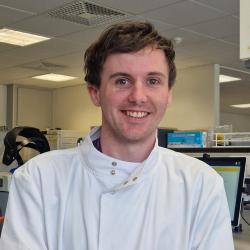Research
The loss of a wanted pregnancy is devasting, and each miscarriage increases the chances of experiencing more losses, regardless of age. Currently, there are no effective treatments to prevent miscarriage or its impact on future pregnancies. Our research has uncovered that an imbalance in certain cell types within the womb lining raises the risk of repeated miscarriages. In a breakthrough, I developed a new 3D cell culture model to mimic this cellular imbalance. My findings revealed that having this imbalance makes the womb lining vulnerable to breakdown during early pregnancy. This cellular imbalance likely stems from excessive stress in rapidly multiplying cells in the womb lining as it regrows following menstruation. My project has two main aims: first, to study the characteristics of the womb lining during the growth phase of the menstrual cycle, before ovulation, in patients facing ongoing fertility struggles, and second, to investigate how an imbalanced womb lining goes onto impact embryo implantation and the beginning of placental development. Long term, by pinpointing these early growth phase womb lining cell defects and how they're controlled, I hope to identify drugs that can target them before ovulation and pregnancy, to remove the risk of harming the implanting embryo. This could lead to major breakthroughs in developing safer and more effective treatments for miscarriage prevention
Publications
Rawlings, TM., Tryfonos, M., Makwana, K., Taylor, D.M., Brosens, J.J., Lucas, E.S. Endometrial Assembloids to Model Human Embryo Implantation In Vitro. In: Zernicka-Goetz, M., Turksen, K. (eds) Embryo Models In Vitro. Methods in Molecular Biology, vol 2767. Humana, New York, NY. 2023
Rawlings TM, Makwana K, Taylor DM, Molè MA, Fishwick KJ, Tryfonos M, Odendaal J, Hawkes A, Zernicka-Goetz M, Hartshorne GM, Brosens JJ, Lucas ES. Modelling the impact of decidual senescence on embryo implantation in human endometrial assembloids. eLife, 2021
Rawlings, TM., Makwana, K., Tryfonos, M., & Lucas, E. S. Organoids to model the endometrium: implantation and beyond, Reproduction and Fertility, 2021
Diniz-da-Costa M, Kong CS, Fishwick KJ, Rawlings TM, Brighton PJ, Hawkes A, Odendaal J, Quenby S, Ott S, Lucas ES, Vrljicak P, Brosens JJ. Characterization of highly proliferative decidual precursor cells during the window of implantation in human endometrium. Stem Cells, 2021
Richardson, SA., Rawlings, TM., Muter, J., Walker, M., Brosens, JJ., Cameron, NR., Eissa, A., Covalent Attachment of Fibronectin onto Emulsion‐Templated Porous Polymer Scaffolds Enhances Human Endometrial Stromal Cell Adhesion, Infiltration, and Function, Macromolecular Bioscience, 201


